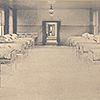Material Objects in Twentieth Century History of Psychiatry
DOI:
https://doi.org/10.18352/bmgn-lchr.10314Keywords:
Medical history, Psychiatry, Material culture, Belgium, 20th century, Nederlandse geschiedenis, Belgische geschiedenisAbstract
Interest in the history of psychiatry in the social sciences manifested itself in the sixties and seventies at a moment when concepts such as marginality and deviance appeared as a thought-provoking path to rewrite the history of Western societies. This history of madness faces a turning point. Material culture, as this paper’s line of argument expounds, allows one to remain faithful to the critical heritage of the sixties and seventies while still opening up the field to alternative questions by integrating new actors and themes hitherto largely ignored. It allows nuanced narratives that take into account the structural imbalances of power while at the same time being attentive to the agencies of all the actors, as well as the failures of the institutional utopias.
This article is part of the special issue 'Blurring Boundaries: Towards a Medical History of the Twentieth Century'.
Materiële objecten in de twintigste eeuwse geschiedenis van psychiatrie
De belangstelling voor de geschiedenis van de psychiatrie in de sociale wetenschappen manifesteerde zich in de jaren zestig en zeventig op een moment dat begrippen als marginaliteit en afwijkend gedrag veelvuldig werden gebruikt om de geschiedenis van de westerse samenlevingen te herschrijven. De geschiedschrijving over krankzinnigheid staat nu op een keerpunt. Door het bestuderen van materiële cultuur, zoals in dit artikel wordt betoogd, maakt het mogelijk om de erfenis van de jaren zestig en zeventig te behouden, maar tegelijkertijd het vakgebied te confronteren met alternatieve vragen door actoren en thema’s te integreren die tot nu toe grotendeels buiten beschouwing gebleven zijn. Dit maakt het mogelijk een genuanceerd betoog te schrijven, daarbij rekening houdend met structurele machtsverschillen, recht te doen aan de verschillende actoren, en tegelijkertijd het falen van de institutionele utopia’s in ogenschouw te nemen.
Dit artikel maakt deel uit van het themanummer 'Blurring Boundaries: Towards a Medical History of the Twentieth Century'.
Downloads

Published
Issue
Section
License
Authors who publish with this journal agree to the following terms:
a) Authors retain copyright and grant the journal right of first publication with the work simultaneously licensed under a Creative Commons Attribution 4.0 International (CC BY 4.0) that allows others to share the work with an acknowledgement of the work's authorship and initial publication in this journal.
b) Authors are able to enter into separate, additional contractual arrangements for the non-exclusive distribution of the journal's published version of the work (e.g., post it to an institutional repository or publish it in a book), with an acknowledgement of its initial publication in this journal.
c) Authors are permitted to post their work online (e.g., in institutional repositories or on their website) prior to and during the submission process.
Authors are explicitly encouraged to deposit their published article in their institutional repository.







